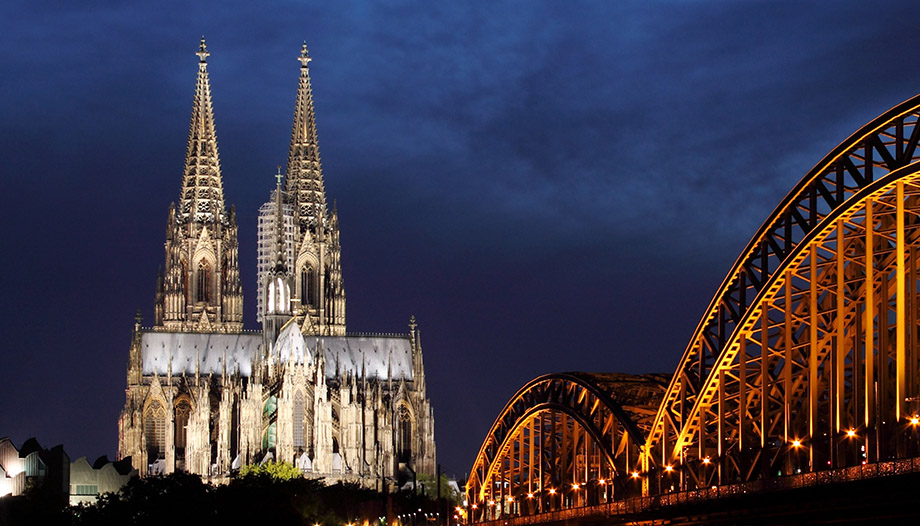Cologne Cathedral, a UNESCO World Heritage Site since 1996, is one of the best-known cathedrals in the world, not least because of its unmistakable silhouette. It is also the most visited monument - by far - in Germany: the number of visitors amounted, in 2022, to 4.3 million, while the new Philharmonie in Hamburg and the Museum Island in Berlin, which rank second and third in this ranking, received 2.8 and 2.2 million visits, respectively.
Brief history of Cologne Cathedral
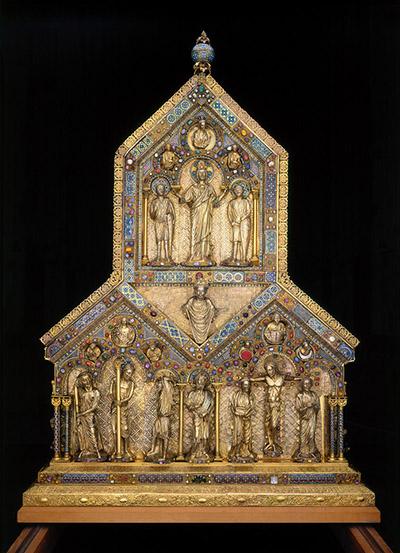
However, the present Gothic cathedral was not the first cathedral in Cologne. When construction began in 1248, Christianity already had a history of at least ten centuries in this city on the Rhine. As its name indicates, Cologne was founded as a Roman colony (Colonia Claudia Ara Agrippinensium, CCAA), on the land occupied at the beginning of our era by the legions I Germanica and XX Valeria Victrix. It was Claudius - emperor between 41 and 54 A.D. - who granted it the status of colonywith more imperial rights than the previous one oppidum. Claudius was married to the Agrippina who gave Cologne its name and who was the daughter of the general Germanicus.
Although there are hardly any sources on the spread of Christianity along the Rhine, it is assumed that it spread slowly, also in Cologne. In any case, the first known bishop is St. Maternus, who is named as such both in the synod of Rome in 313 and in the synod of Arles in 314. After the fall of the Roman Empire and the rise of new kingdoms, the first documented bishop of the Frankish period is Evergislus (Eberigisil) in the 6th century. Bishop Hildebold received the title of archbishop from Charlemagne in 794-795. Since then, Cologne has been an archbishopric.
Although there are remains of earlier buildings, such as a late Roman baptistery and a Merovingian church from the 6th century, Cologne's first cathedral - the Carolingian cathedral - dates from the 9th century. Although it is often referred to as "Hildebold Cathedral", construction probably did not begin until after Hildebold's death in 818. It was consecrated in 870.
The Three Wise Men and Cologne Cathedral
On the site of this Carolingian cathedral, which Archbishop Konrad von Hochstaden had demolished in April 1248, construction of the present cathedral began; the bishop laid the foundation stone on August 15, 1248. The construction of a new, much larger and richer cathedral is closely connected with the Magi, whose relic Archbishop Rainald von Dassel brought from Milan to Cologne in 1164. Considered to be one of the most important relics of Christianity, a luxurious reliquary, made by the goldsmith Nicholas of Verdun between 1190 and 1225, is not only created to house them, and is considered to be the largest and most artistically accomplished preserved from the Middle Ages. In addition, this new cathedral is conceived as a kind of "reliquary" or "reliquary in stone". The cathedral chapter decided that it should be built in the Gothic style of the French cathedrals and that it should surpass in height the twelve Romanesque basilicas that already existed in the city.
– Supernatural translatio The Three Wise Men is a response to Emperor Frederick I Barbarossa's idea of "sacralizing" the empire, independently of and on the same level as the sancta ecclesia. To do this, he carried out three acts: first, in 1157 he added to imperium the predicate sacrumSince then, the expression "Holy Roman-Germanic Empire" spreads. Secondly, the "wise men from the East" (Mt 2:1) became the "three Magi", following the Old Testament tradition of, for example, Psalm 72 (71): "Let the kings of Sheba and Arabia offer him their gifts; let all the kings prostrate themselves before him". Thirdly, Frederick I ordered the canonization of Charlemagne: since Archbishop Rainald von Dassel of Cologne canonized him in Aachen in 1165, the emperor could count among his rowsnot only with the kings magicians, but also with a king saint.
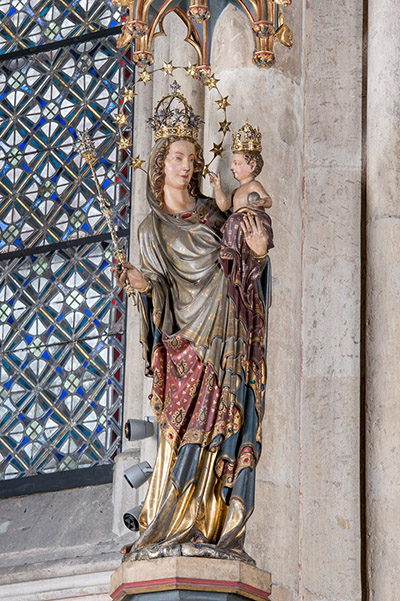
It took more than six centuries to complete its construction: although construction began between 1248 and 1528, following the plans of the master builder Gerhard, work was interrupted for almost 300 years: it was not until 1823 that it was decided to complete the construction, following the original plans: on September 4, 1842, the King of Prussia Frederick William IV - after the Napoleonic wars, the Rhineland became a Prussian province - and Archbishop Johannes von Geissel lay the first stone for the construction of the western facade with the characteristic towers, 157 meters high; the completion is officially celebrated on October 15, 1880, although the mosaic of the choir would not be finished until 1899.
Relics and images of great devotion and artistic value
In addition to the relic of the Magi, Cologne Cathedral houses a number of masterpieces such as the Gero Cross ("Gerokreuz"), so called because it was commissioned by Archbishop Gero (bishop between 969 and 976). It is one of the oldest large crucifixes (2.88 meters) that have been preserved north of the Alps: made of oak wood towards the end of the 10th century, iconographically it is considered a turning point in the representation of the Savior; until then, depicted victorious in an upright position, he now appears suffering and human. Possibly it is due to new trends in theology, which at the end of the tenth century placed the redemptive death of Christ at the center of the doctrine. The Gero Cross served as a model for numerous medieval representations.
The third object of veneration, after the Magi and the Gero Cross, is the "Madonna of Milan" ("Mailänder Madonna") in the Cathedral. Sculpted around 1290 in polychrome wood, it is currently the oldest image of the Madonna in the Cathedral. Its name is due to the fact that it replaced a statue that Rainald von Dassel brought from Milan together with the Magi and that was destroyed in the fire of the previous cathedral. Of Gothic style, it is closely related to the figures of the choir pillar, a highlight of the Mannerist style of the full Gothic.
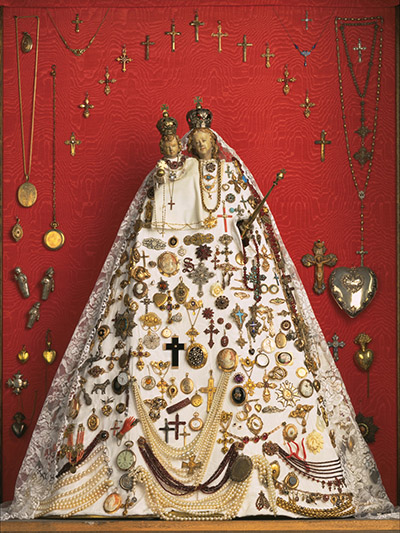
In the chapel of daily celebration during the summer months - in winter, daily masses are celebrated in the chapel of the Most Holy - stands another of the cathedral's jewels: the altarpiece "of the Patrons of the City", considered to be Stefan Lochner's most important work and one of the most outstanding works of medieval painting in Cologne. The triptych, commissioned by the city council in 1426, has been in the cathedral since 1809. Merging Italian coloring with Flemish realism, Stefan Lochner depicted on the central panel the Magi adoring the Christ Child on the lap of his enthroned mother. In the wings are depicted the patron saints of Cologne: on the left, St. Ursula with her "eleven thousand virgins"; on the right, St. Gereon with soldiers of the Theban Legion. On the outside, when the altar is closed, the Annunciation of Mary can be seen.
One of the images that enjoy the greatest devotion is the "Schmuckmadonna" ("Virgin of the votive offerings"), as attested by the large number of candles that can always be found burning in front of it. The image is adorned with numerous pieces of jewelry from the 19th and 20th centuries as votive offerings in thanksgiving for favors received. The veneration of the image dates back to the end of the 17th century.
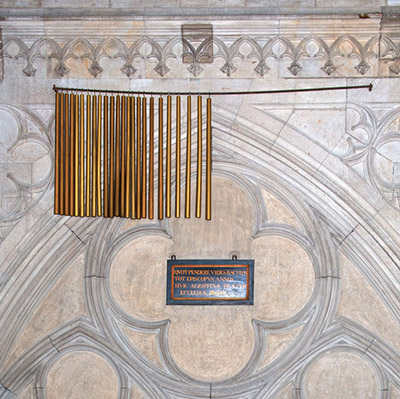
Next to this image hang the "annual croziers": in gold-covered wood, they are placed above the entrance to the Treasure Chamber and indicate how many years the current archbishop has been in office. Year after year, another crozier is added on the anniversary of the archbishop's inauguration. Thus the inscription reads: "Quot pendere vides baculos, tot episcopus annos huic Aggripinae praefuit" ("As many croziers as you see hanging, so many years the bishop of Cologne resides"). The origin of this custom is unknown, but it appears in the travel report of Arnoldus Buchelius, from Utrecht, in 1587.
Buried personalities
In Cologne Cathedral are buried, besides some personalities such as Richeza, Queen of Poland (995-1063), the bishops of the diocese: from the aforementioned Gero († 976) and Rainald von Dassel († 1167) to the last ones, Cardinals Josef Frings († 1978), Joseph Höffner († 1987) and Joachim Meisner († 2017), the latter in the crypt built between 1958 and 1969.




